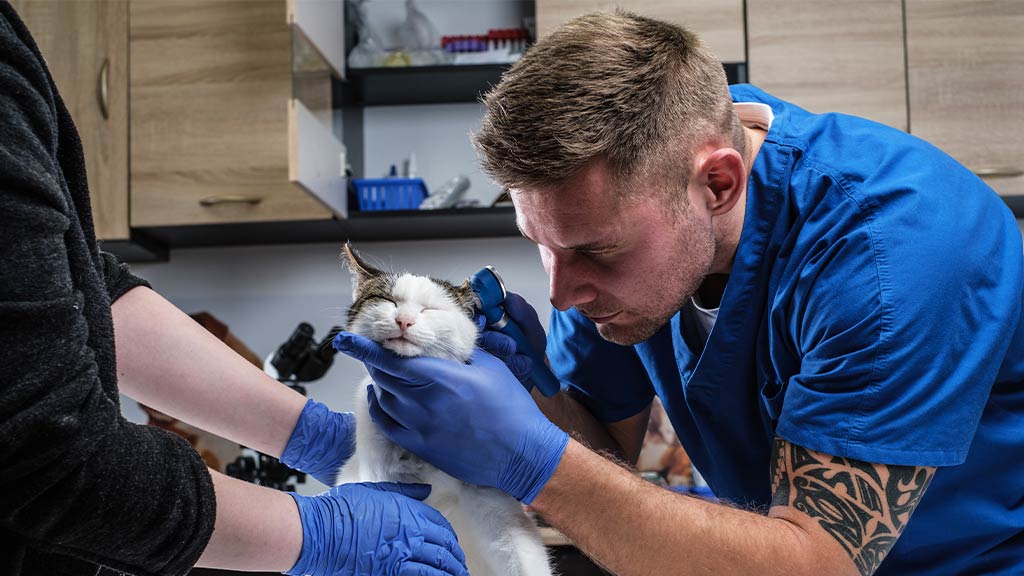Your cat’s ears looking a little crusty? If they scratch, shake, or side-eye you, it’s time to learn how to clean your cat’s ears—before it turns into a real problem.
Cleaning your cat’s ears might not be the first thing on your pet care checklist, but it’s a key part of keeping them healthy. Though known for self-grooming, cats still need regular ear cleaning. It prevents infections, reduces wax buildup, and keeps your cat comfortable by removing potential irritants that can affect their hearing.
Remember, cats depend on their hearing for communication and environmental awareness, making ear health important. Neglecting regular ear cleaning of your cat can cause hearing loss and other health issues, including ear canal swelling.
If you’re a cat parent, a professional groomer, or a veterinarian, knowing how to clean your cat’s ears makes a difference.
Let’s break it down step by step.
Why Cleaning Your Cat’s Ears Matters
Cats are instinct-clean animals, but their ears need extra attention. Unlike humans, cats’ ear canals are shaped like an “L,” which makes them a magnet for dirt, wax, and gunk. Over time, this buildup creates a warm, moist environment where bacteria, yeast, and mites can grow. Left unchecked, these issues lead to painful infections, chronic inflammation, or even deafness.
Regular cleaning removes harmful debris and helps you spot early signs of problems like redness, swelling, or unusual odors. For pet professionals, this is part of routine feline care, but for pet owners, it’s an easy way to keep their cat’s health on track.
Spot the Signs: When Your Cat’s Ears Need Cleaning
You probably thinking, “How do I know when it’s time to clean my cat’s ears?” Don’t worry, we’ll educate you on this. Note the following behaviors in your cat:
- Excessive scratching, head shaking, or visible wax buildup
- If your cat tilts their head frequently or rubs their ears against furniture
- A foul smell or dark discharge: it could mean an infection or mites
Remember, some cats are more prone to ear issues than others, especially breeds with folded ears, like Scottish Folds, or those with long fur that traps debris. Regular ear inspections, at least once a week, help catch these issues early and keep your cat comfortable.
How Often Should You Clean Your Cat’s Ears?
The frequency of ear cleaning depends on your cat’s breed, lifestyle, and health. For most cats, a monthly cleaning is enough to keep their ears in shape. However, cats with a history of ear problems or those who spend time outdoors may need more frequent care since they are exposed to more dirt and parasites.
If your cat has chronic ear infections or allergies, your vet may recommend a customized cleaning schedule. Over-cleaning strips the ears of natural oils, leading to dryness and irritation, so finding the right balance is key. Still unsure, consult your veterinarian to determine the best routine for your cat.
Gear Up: What You’ll Need to Clean Your Cat’s Ears
Before you start, grab these essentials.
You’ll need a vet-approved ear-cleaning solution to break down wax and debris without irritating your cat’s ears. Cotton balls or gauze pads work best for wiping away dirt. Avoid Q-tips or alcohol-based products because they can push debris deeper into the ear canal and cause damage. Use treats and positive reinforcement to make the experience less stressful for your cat.
For pet professionals, having a well-stocked kit with different solutions and cleaning tools is important for providing high-quality care.
Step-by-Step Guide on How to Clean Your Cat’s Ears
Prepare Your Cat: Choose a quiet, comfortable space where your cat feels safe. Gently hold them and reassure them with a calm voice. If your cat tends to squirm, wrapping them in a soft towel can help keep them still without causing stress.
Inspect the Ears: Before applying any solution, check for signs of redness, swelling, or discharge. If you notice anything unusual, stop and consult your vet to avoid worsening an underlying condition.
Apply the Cleaning Solution: Hold the ear flap upright and squeeze a few drops of the vet-approved cleaner into the ear canal. Be gentle and avoid inserting the bottle tip too deeply.
Massage the Base: Using your fingers, gently massage the base of the ear for about 20-30 seconds. This helps the solution break up wax and loosen debris inside the canal.
Wipe Away Debris: Use a cotton ball or gauze pad to wipe the outer ear and visible parts of the ear canal. Avoid pushing debris further inside, as this can cause blockages.
Reward Your Cat: Offer a treat and gentle praise to make the experience positive. Over time, your cat will associate ear cleaning with rewards, making the process easier in the future.
Common Mistakes to Avoid (Seriously, Don’t Do These)
One of the biggest mistakes is using the wrong products. Avoid human ear cleaners, hydrogen peroxide, or homemade vinegar solutions, for example. They can irritate your cat’s sensitive ears, leading to pain and infection.
Another mistake is over-cleaning, which removes protective oils and leads to chronic dryness or irritation. Forcing the process or scrubbing too hard can also create a negative association, making future cleanings difficult.
Always follow your vet’s advice and use gentle, cat-safe products.
When to Consult a Veterinarian
While regular cleaning is helpful, some issues need professional attention. Consult your vet if
- Your cat shows signs of pain, such as yelping, pulling away, or aggressive behavior when you touch their ears.
- You notice a persistent odor, excessive wax buildup, or swelling as it could mean a serious infection, ear mites, or an allergic reaction.
- Your cat has chronic ear issues and may need medication or prescription cleaners to manage their condition.
For pet parents, knowing when to visit a veterinarian helps ensure the best care for their pets.
Final Words!
Cleaning your cat’s ears doesn’t have to be stressful. With the right tools, techniques, and a little patience, you can make it a simple and positive experience for your cat. Regular inspections and gentle cleaning help prevent infections and keep your cat’s ears in good shape. If you ever feel unsure, your vet is the best resource for guidance. A little extra care makes a big difference, and your cat will appreciate it!
FAQs – How to Clean Your Cat’s Ears
- Can I use baby wipes to clean my cat’s ears?
No, baby wipes can contain chemicals that irritate your cat’s ears. Always use a vet-approved cleaning solution.
- How do I know if my cat has ear mites?
Check for symptoms like dark, crumbly discharge, excessive scratching, and head shaking. A vet can confirm the diagnosis.
- Is it normal for my cat to shake their head after cleaning?
Yes, mild head shaking is normal as your cat adjusts to the sensation. However, persistent shaking could indicate a problem.
- Can I clean my cat’s ears if they have an infection?
No, cleaning an infected ear can worsen the issue. Consult your vet for proper treatment.
- Do indoor cats need their ears cleaned as often as outdoor cats?
Indoor cats generally need less frequent cleaning, but regular inspections are still important to catch any issues early.

